Imagine riding your motorcycle on a crisp morning, feeling the wind against your face, only to have it sputter and stall like a car running out of gas. It's frustrating, but understanding common technology issues can help you avoid these pitfalls. From electrical glitches to fuel injection problems, you can tackle these challenges with the right knowledge and tools. The question is, how do you pinpoint the source of the trouble before it derails your ride? Let's explore the most frequent issues that can affect your motorcycle's performance and the steps you can take to resolve them efficiently.
Quick Takeaways
- Regularly inspect and clean battery terminals to prevent dead battery issues and ensure smooth power flow.
- Monitor fuel filters and injectors for clogs or dirt that can hinder engine performance.
- Use a multimeter to diagnose electrical problems, such as shorts or dead circuits in wiring.
- Check ABS warning lights and brake fluid levels to identify potential malfunctions in the braking system.
Overview of Suzuki Motorcycle Technology
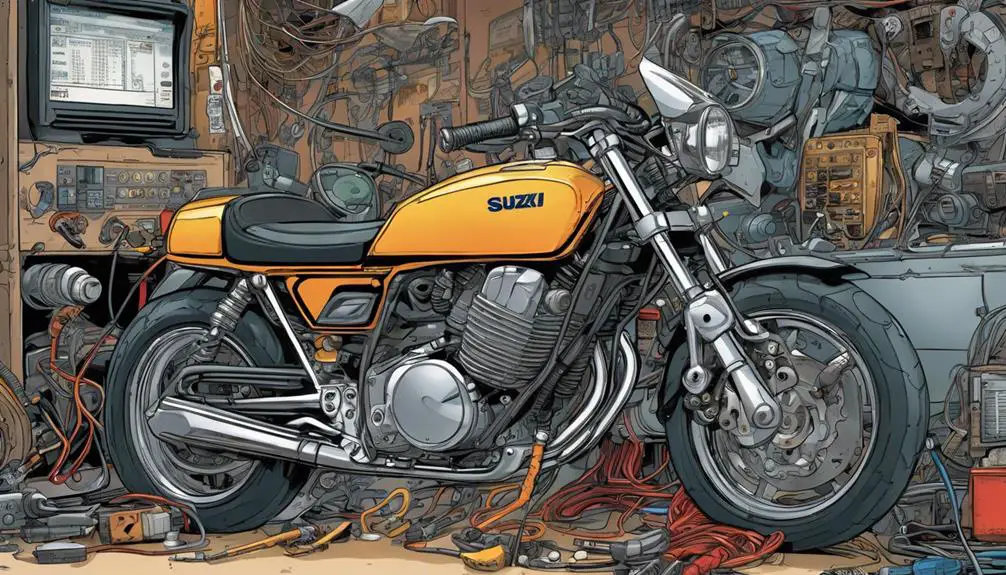
Suzuki motorcycles pack advanced technology that enhances performance, safety, and rider experience. You'll find innovative features designed to give you the freedom to conquer the open road with confidence. From lightweight frames to powerful engines, every component is engineered to maximize your ride's efficiency and agility.
One standout aspect is Suzuki's advanced traction control systems. These systems adapt to different road conditions, allowing you to maintain grip without compromising speed. You can ride through rain or gravel with certainty, knowing your bike is working hard to keep you upright.
Additionally, Suzuki's cutting-edge fuel injection systems guarantee peak power delivery while reducing emissions. This means you not only get to ride longer between fill-ups, but you also contribute to a cleaner environment.
Don't forget about the all-encompassing braking systems, featuring anti-lock braking technology that enhances safety in critical moments. These innovations empower you to focus on the experience, enjoying the freedom of the ride without worry.
With Suzuki, you're not just riding a motorcycle; you're embracing a lifestyle of liberation and adventure, where every twist of the throttle leads to new horizons.
Common Electrical Problems
Even with advanced technology enhancing performance, electrical problems can still arise in motorcycles, impacting your ride and safety. You might experience issues like a dead battery, faulty wiring, or malfunctioning lights. These problems can leave you stranded or compromise your visibility on the road.
A dead battery often results from leaving lights on or a failing charging system. If you turn the key and nothing happens, check the battery connections and charge levels first. Loose or corroded terminals can disrupt power flow, so give those a good look.
Faulty wiring can lead to shorts, causing lights or signals to flicker or fail entirely. Inspect your wiring harness for any signs of wear, fraying, or damage. If you find any issues, it's essential to repair them to avoid further complications.
Lastly, if your indicators or headlights aren't working, it could be as simple as a blown fuse. Check your fuse box and replace any blown fuses to restore functionality.
Fuel Injection Issues
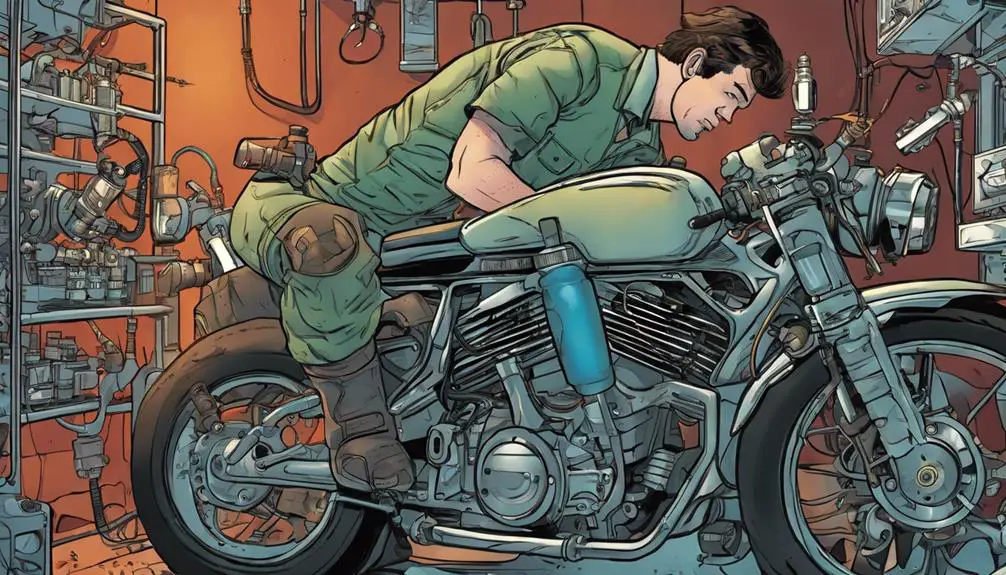
Fuel injection issues can lead to poor engine performance, causing your motorcycle to hesitate or stall unexpectedly. If you notice these symptoms, it's time to dig deeper.
First, check your fuel filter. A clogged filter restricts flow, which can starve your engine.
Next, inspect the fuel injectors themselves. Dirty or malfunctioning injectors can disrupt the spray pattern, leading to uneven fuel delivery. Cleaning them with a specialized solution might just restore your ride's freedom.
Don't forget to examine the fuel pump. Low pressure can result from wear, age, or even debris in the system. Verify the pump's working efficiently, as it's crucial for maintaining the flow.
Additionally, look for any air leaks in the intake system. Air leaks can mess with the air-fuel mixture, causing your bike to run lean or rich.
Lastly, keep an eye on your motorcycle's throttle position sensor (TPS). If it's out of whack, it can lead to poor acceleration and stalling.
Engine Control Unit Malfunctions
Your motorcycle's engine control unit (ECU) can experience malfunctions that disrupt performance and lead to frustrating riding experiences. When the ECU misfires, you might notice poor acceleration, stalling, or erratic idling. These issues can strip away the freedom you crave on the open road.
Start by checking for error codes using a diagnostic tool. If you see a code, it's your first clue. Don't ignore it! Sometimes, a simple reset can clear the issue. If the problem persists, inspect the wiring and connectors. Loose or damaged connections can wreak havoc on your ECU's performance.
Next, take a look at the sensors—especially the throttle position and oxygen sensors. A malfunctioning sensor can send incorrect data to the ECU, leading to performance hiccups.
ABS System Failures
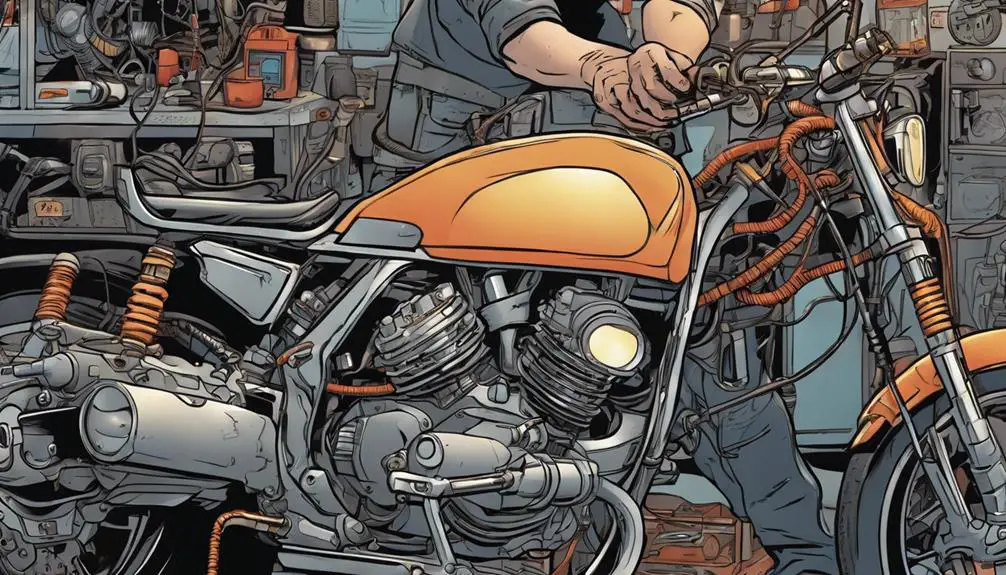
ABS system failures can compromise your motorcycle's braking performance, making it vital to address any issues promptly.
When your ABS isn't working, you might notice the warning light illuminating on your dashboard, which signals a problem. Don't ignore it; this system is critical for maintaining control during sudden stops or slippery conditions.
If you find your brakes feeling spongy or unresponsive, it could indicate a malfunction in the ABS module. Check the brake fluid levels and verify there are no leaks. A low fluid level can lead to a complete brake failure, which is something you definitely want to avoid!
Additionally, listen for unusual sounds when you brake. Grinding or squealing can indicate that your ABS is struggling to function correctly.
If you experience any of these symptoms, don't hesitate to consult a professional.
Diagnostic Tools and Techniques
When you troubleshoot motorcycle technology issues, having the right diagnostic tools at your disposal is essential.
You'll want to familiarize yourself with common error codes and learn how to analyze performance data effectively.
These skills can make all the difference in identifying and resolving problems quickly.
Essential Diagnostic Equipment
Having the right diagnostic equipment is vital for efficiently identifying and resolving motorcycle technology issues.
When you're out there, the freedom of the open road can be interrupted by unexpected problems, but with the right tools, you can regain control.
Start with a quality multimeter; it's your best friend for testing electrical systems. This tool helps you check the battery, diagnose wiring issues, and verify everything's functioning properly.
Next, consider an OBD-II scanner, especially if your motorcycle has electronic systems. This handy device reads fault codes, allowing you to pinpoint specific issues quickly. It empowers you to understand your bike's performance deeply.
Don't forget about a good set of hand tools. Wrenches, screwdrivers, and pliers will let you make necessary adjustments and repairs on the spot.
A tire pressure gauge is also important; keeping your tires at the right pressure guarantees safety and performance.
Common Error Codes
Understanding common error codes is essential for diagnosing issues with your motorcycle's electronic systems effectively. When you encounter a warning light or error message, these codes can guide you to the root of the problem. Most modern motorcycles use On-Board Diagnostics (OBD) systems that generate specific codes when an issue arises. You'll typically find these codes listed in your motorcycle's service manual or online.
To start troubleshooting, connect a diagnostic tool to your bike's OBD port. The tool will read the error codes and display them on its screen. Pay attention to what each code signifies; they often point directly to malfunctioning components, whether they're sensors, fuel injectors, or wiring issues.
Don't ignore these codes—they're your allies in achieving motorcycle freedom. By understanding what each code means, you empower yourself to make informed decisions about repairs and maintenance. Remember, addressing potential problems early can save you time and money down the road.
Analyzing Performance Data
Analyzing performance data is essential for optimizing your motorcycle's efficiency and ensuring a smooth ride. By tapping into diagnostic tools, you can reveal valuable insights about your bike's performance metrics. Start with an OBD-II scanner, which connects to your motorcycle's onboard computer. This handy device reads error codes, fuel efficiency, and other critical data, giving you a clear view of your bike's health.
Next, consider using performance monitoring apps that track real-time data like RPM, throttle position, and even temperature. These apps can help you identify patterns and anomalies, allowing you to make informed adjustments.
Don't forget about the power of your senses; listen for unusual sounds and feel for vibrations that signal underlying issues.
Regularly analyze your data and make necessary adjustments, whether it's tuning the fuel mixture or adjusting the suspension settings. Remember, it's all about liberation on the road—an agile, responsive motorcycle can transform your ride.
Embrace this tech-savvy approach to motorcycle maintenance and take charge of your riding experience. The freedom of the open road awaits, and a well-tuned machine makes every journey more exhilarating.
Software Updates and Upgrades
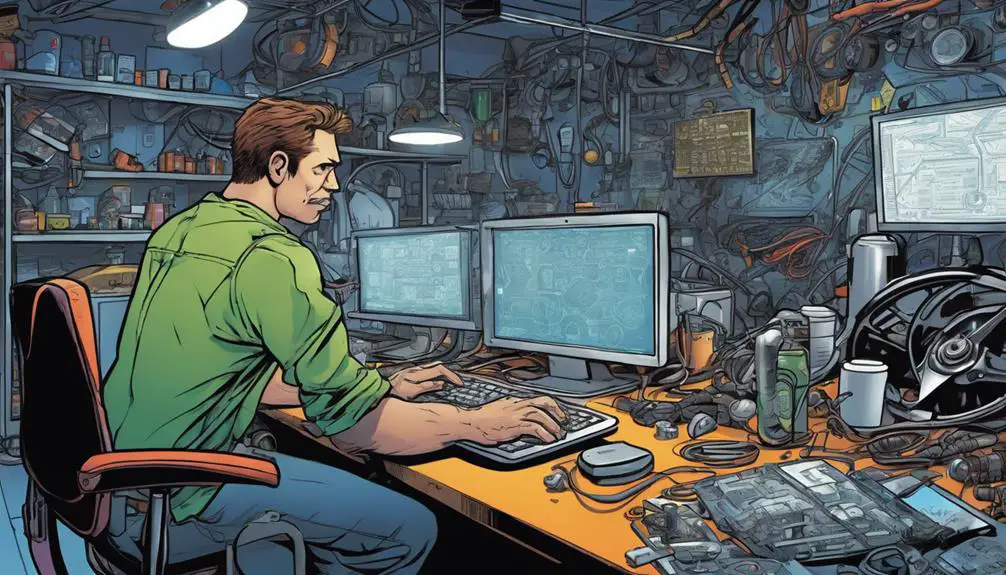
Software updates and upgrades are essential for keeping your motorcycle's technology running smoothly and securely. By staying current with these updates, you release the full potential of your ride, guaranteeing that you experience all the freedom and power it has to offer. Ignoring software updates can lead to bugs, reduced performance, or even security vulnerabilities.
Here are a few reasons why you shouldn't overlook them:
- Improved Performance: Updates often include tweaks that enhance speed, handling, and overall efficiency.
- Security Enhancements: New software can patch vulnerabilities, protecting your bike from potential threats.
- Feature Additions: Manufacturers may introduce new functionalities that make your riding experience even more enjoyable.
Maintenance Tips for Longevity
To keep your motorcycle running smoothly, you need to focus on a few key maintenance tips.
Regular software updates, proper battery care, and cleaning electrical connections can greatly extend its lifespan.
Let's explore these essential practices to guarantee your ride stays in top shape.
Regular Software Updates
Regularly updating your motorcycle's technology not only enhances performance but also guarantees safety and reliability on the road.
When you keep your software current, you're taking a powerful step towards affirming that your ride runs smoothly and efficiently. Embracing these updates allows you to enjoy an experience that's not just exhilarating but also liberating.
Here are some key reasons to stay on top of those updates:
- Improved Functionality: New software versions often come with bug fixes and enhancements that boost performance.
- Enhanced Security: Updates can patch vulnerabilities, protecting your ride from potential threats.
- Compatibility: Keeping software current affirms your motorcycle's systems work seamlessly with the latest accessories and tech.
Don't underestimate the power of a simple update. It's a straightforward way to keep your motorcycle responsive and in tune with the latest innovations.
Battery Care Practices
Maintaining your motorcycle's battery is vital for ensuring reliable performance and longevity on every ride.
Start by checking the battery's fluid levels regularly; if you've got a conventional lead-acid battery, keep the electrolyte above the plates. If it's low, top it up with distilled water.
Next, clean the terminals and cable connections; dirt and corrosion can hinder electrical flow. Use a wire brush and a solution of baking soda and water to keep things flowing smoothly.
Don't forget to charge your battery if it's been sitting idle for a while. A fully charged battery is essential for peak performance.
If you're not riding for an extended period, consider using a battery maintainer to prevent it from discharging.
Cleaning Electrical Connections
Keeping electrical connections clean is essential for your motorcycle's performance and helps prevent costly repairs down the road. Dirt, grime, and corrosion can create resistance in your electrical system, leading to poor performance or even failure.
To keep your ride liberated and running smoothly, follow these cleaning tips:
- Disconnect the Battery: Always start by disconnecting the battery to prevent any shorts or shocks.
- Use the Right Tools: Grab a wire brush, contact cleaner, and a soft cloth to effectively clean the connections.
- Check for Corrosion: Inspect the connectors for any signs of corrosion and remove it carefully. If corrosion is severe, consider replacing the connectors.
When to Seek Professional Help
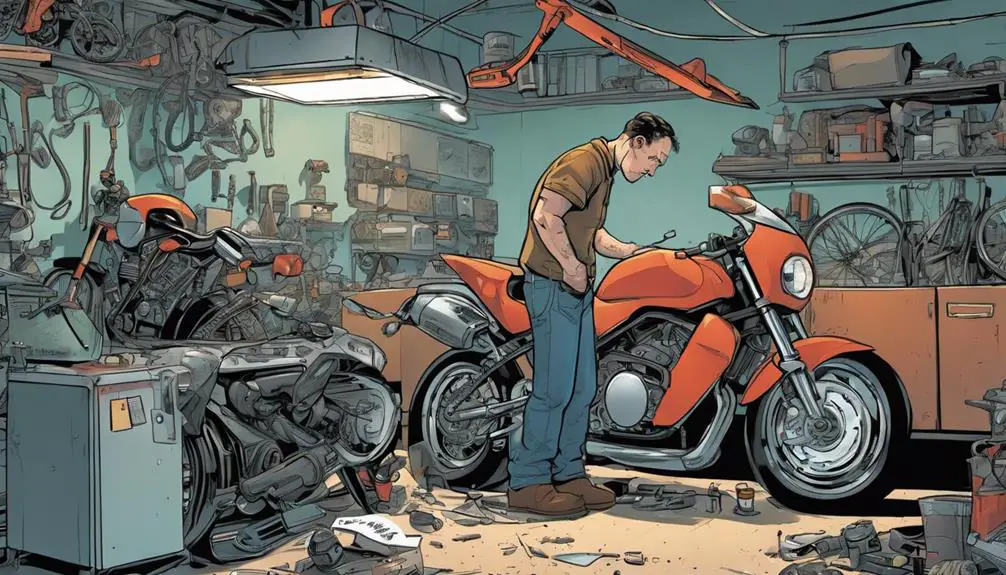
Knowing when to seek professional help can save you time and money while ensuring your motorcycle stays in top condition. If you're facing persistent issues that resist your troubleshooting efforts, it's a strong signal that it's time to call in the experts. Don't let pride keep you from getting the assistance you need to release your ride's full potential.
When you notice strange noises, erratic electrical behavior, or performance drops that you can't fix, it's essential to consult a professional. These symptoms often indicate deeper underlying problems that could lead to costly repairs down the line if ignored.
Also, if your motorcycle's warning lights stay lit after you've tried everything, don't hesitate to reach out for help.
Common Questions
How Can I Identify a Faulty Ignition Coil on My Motorcycle?
To identify a faulty ignition coil on your motorcycle, you'll want to start by checking for spark.
Remove a spark plug and connect it to the ignition coil, then crank the engine. If you don't see a strong spark, the coil might be bad.
You can also measure the resistance with a multimeter; it should match your bike's specifications. If it's out of range, it's time for a replacement.
What Are the Signs of a Failing Motorcycle Battery?
Imagine the freedom of the open road suddenly stalling—your motorcycle's battery might be to blame.
If you notice dimming lights, a sluggish start, or electrical components acting up, it's time to pay attention. A failing battery can leave you stranded, robbing you of that exhilarating ride.
Don't ignore strange sounds or a battery that's swelling or leaking.
Trust your instincts; a fresh battery can restore your two-wheeled liberation.
Can I Use Car Oil in My Motorcycle Engine?
You might think using car oil in your motorcycle engine is a quick fix, but it's not ideal.
Motorcycle engines require oil designed for their specific needs, which includes additives for high RPMs and clutch performance.
Car oil usually lacks these features, risking engine damage or performance issues.
Stick with motorcycle-specific oil to guarantee your ride runs smoothly and you can enjoy the freedom of the open road without worries.
How Often Should I Check My Tire Pressure?
You should check your tire pressure at least once a month and before any long rides.
Keeping your tires properly inflated not only enhances your safety but also boosts your bike's performance and fuel efficiency.
Don't forget to check them when they're cold for the most accurate reading.
By staying diligent about tire pressure, you're ensuring a smoother ride and freeing yourself from potential issues on the road.
Keep rolling with confidence!
What Tools Are Essential for Basic Motorcycle Maintenance?
Think of essential tools as your motorcycle's lifeline.
You'll need a good set of wrenches, screwdrivers, and pliers to tackle basic maintenance tasks. A torque wrench guarantees everything's tightened just right, while a tire pressure gauge keeps your ride safe and smooth.
Don't forget a quality oil filter wrench and a chain cleaner.
With these tools, you're not just maintaining; you're empowering your freedom on the open road.
Enjoy the ride!
Wrapping Up
To sum up, staying proactive with your motorcycle's technology can save you from frustrating breakdowns.
For example, if you notice your bike's engine sputtering during acceleration, it might be a clogged fuel filter.
By addressing such issues early, you not only enhance safety but also enjoy a smoother ride.
Remember, regular inspections and updates can make a world of difference in your motorcycle's performance.
Don't hesitate to seek professional help if problems seem beyond your expertise.